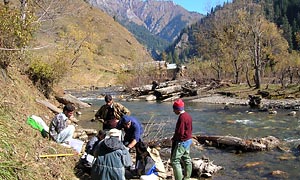The response of fish habitat and imperiled fishes to extreme geomorphic change in a historically degraded desert river
Date:
April 2020 – May 2022
Abstract:
Global freshwater biodiversity is threatened by a wide array of hydrologic alterations resulting from increased water demand, land-use alteration and climate change. Coinciding with these alterations is increased habitat simplification in rivers occupied by many endangered fishes, resulting in population declines and widespread extirpation. The overall goal of this study is to document extreme geomorphic change in a historically degraded desert river tributary as it relates to the creation of fish habitat and use by fish species. In 2010, a large reach of the San Rafael River (SRR; tributary to Colorado River Basin (CRB)), began to actively change from a simple single-thread channel to a complex shallow, multi-thread channel. We used ArcGIS and field surveys to document changes in this river system from the establishment of the wash habitat feature. We also monitored movement and habitat use of the lower river by protected, endemic river fishes including bonytail (Gila elegans). Based on preliminary analyses, this altered reach of river is more diverse than any other region along the lower SRR with wash habitat reaches containing 17% more complex habitat based on field sampling (e.g., pools, riffles, backwaters) on average than reference reaches, and 70% of the primary wash habitat feature comprised of complex habitat. The habitat feature is also providing resilience in the face of drought, retaining water for periods beyond what is expected during seasonal drying. We observed that of 3,546 released and tagged bonytail, 79% remained in the system for at least 3 months prior to seasonal drying. Additionally, based on electivity analyses, 3 of the 8 sampled fish species were selecting this relatively new complex wash habitat, and complex habitat contained a greater diversity of fish species. Direct evidence of significant geomorphic change could offer insight into “low tech” restoration opportunities and recovery of endangered desert fish species.
Funding:
- Bureau of Reclamation in partnership with the Bureau of Land Management.
- Utah Division of Wildlife Resources (In-kind)
- US Geological Survey – Utah Cooperative Fish and Wildlife Research Unit (In-kind)
- The Ecology Center at Utah State University
Investigators:
- Tansy Remiszewski, M.S. candidate
- Dr. Phaedra Budy, U.S. Geological Survey - UCFWRU, Dept. of Watershed Sciences, USU
- Gary Thiede, Dept. of Watershed Sciences, USU
- Peter MacKinnon, Biomark Inc. & Dept. of Watershed Sciences, USU
Other Collaborators:
- David Speas, Bureau of Reclamation
- Joseph Wheaton, USU - Dept. of Watershed Sciences
- Daniel Keller, Utah Division of Wildlife Resources

Tansy Remiszewski holding a stocked and tagged, endangered bonytail chub on the San Rafael River, summer of 2020.


